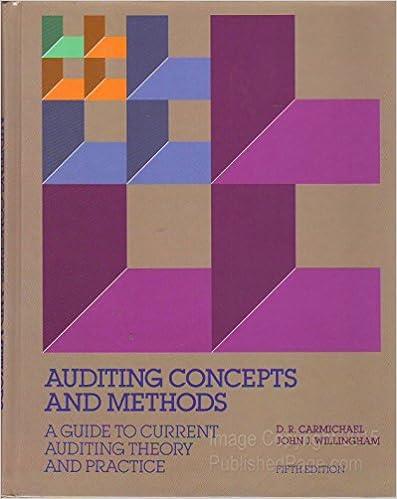The following questions relate to direct tests of balances for accounts receivable and accounts payable. Select the
Question:
The following questions relate to direct tests of balances for accounts receivable and accounts payable. Select the best response.
a. Which of the following is the best argument against the use of negative accounts receivable confirmations?
1. The cost-per-response is excessively high.
2. There is no way of knowing if the intended recipients received them.
3. Recipients are likely to feel that in reality the confirmation is a subtle request for payment.
4. The inference drawn from receiving no reply may not be correct.
b. Customers having substantial year-end past due balances fail to reply after second request forms have been mailed directly to them. Which of the following is the most appropriate audit procedure?
1. Examine shipping documents.
2. Review collections during the year being audited.
3. Intensify the procedures to test the effectiveness of the internal control structure elements with respect to receivables.
4. Increase the balance in the accounts receivable allowance (contra) account.
c. In determining the adequacy of the allowance for uncollectible accounts, the least reliance should be placed upon which of the following?
1. The credit manager's opinion.
2. An aging schedule of past due accounts.
3. Collection experience of the client's collection agency.
4. Ratios calculated showing the past relationship of the valuation allowance to net credit sales.
d. Which of the following procedures relating to the examination of accounts payable could the auditor delegate entirely to the client's employees?
1. Test footings in the accounts payable ledger.
2. Reconcile unpaid invoices to vendors' statements.
3. Prepare a schedule of accounts payable.
4. Mail confirmation for selected account balances.
e. Which of the following is the most efficient audit procedure for the detection of unrecorded liabilities at the balance sheet date?
1. Confirm large accounts payable balances at the balance sheet date.
2. Compare cash disbursements in the subsequent period with the accounts payable trial balance at year-end.
3. Examine purchase orders issued for several days prior to the close of the year.
4. Obtain an attorney's letter from the client's attorney.
f. Auditor confirmation of accounts payable balances at the balance sheet date may be unnecessary because
1. This is a duplication of cutoff tests.
2. Accounts payable balances at the balance sheet date may not be paid before the audit is completed.
3. Correspondence with the audit client's attorney will reveal all legal action by vendors for nonpayment.
4. There is likely to be other reliable external evidence available to support the balances.
Step by Step Answer:

Auditing Concepts And Methods A Guide To Current Auditing Theory And Practice
ISBN: 9780070099999
5th Edition
Authors: Mcgraw-Hill





